
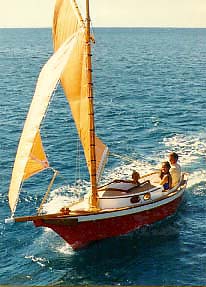
The Weekender
What would one of the old master boat designers do with modern tools and
materials? That was the question we set out to explore when we designed
the first WEEKENDER as the featured boat plan for Popular Science magazine
back in 1981.
We went with a simplified, stressed-skin plywood box-section hull that eliminated
almost all the intricate inner framing of the old boats.
The result was an extremely rigid, self-aligning structure that pulls itself
straight as you build. This worked great for reducing building time, but
it also had some other bonuses that we weren't expecting.
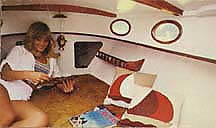
Inside, there's over six feet of sleeping room for two (It's true. We got
a letter from one couple who spent two summer vacations on their WEEKENDER
without a divorce). The reason for the extra room inside is the absence
of a centerboard trunk that usually sits square in the middle of where you
want to be.
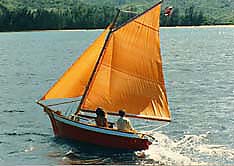
Hull-building is just like building a plywood box. In fact, it is just building
a plywood box. After nailing together the keel, we cut out the deck, bottom,
and bulkhead parts, assemble the deck and bottom, screw the bottom down
onto the keel, then fit the bulkheads and deck down in place. If we keep
the centerlines of the parts lined up, there's no way the boat can come
out lop-sided. And once the side panels are screwed to the edges of the
deck and bottom, the whole box-section becomes extremely rigid. Inside,
parts like seat-bottoms and shelves double as side-framing. You'll find
a lot of parts on the WEEKENDER doing double-duty. That's what keeps it
light.
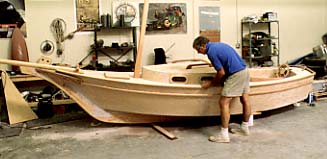 All this, including rigging and sailing speed-secrets, along with all the
building steps, is covered in the new over 3 hour Video Home Boat Building
Course that goes into tool-use techniques, painting tips, even how a beginner
can handle giving the boat a protective coat of fibreglass for low maintenance-even
making your own steering wheel if you can't find one in a nautical shop.
Although the whole boat can be built from standard lumberyard stock and
hardware, using common hand tools, a lot of WEEKENDER builders like to upgrade
their craft with the latest in racing gear and custom-made sails. So the
Video goes into tips about upgrading your boat; what we think is worth the
extra money, and what may not be.
All this, including rigging and sailing speed-secrets, along with all the
building steps, is covered in the new over 3 hour Video Home Boat Building
Course that goes into tool-use techniques, painting tips, even how a beginner
can handle giving the boat a protective coat of fibreglass for low maintenance-even
making your own steering wheel if you can't find one in a nautical shop.
Although the whole boat can be built from standard lumberyard stock and
hardware, using common hand tools, a lot of WEEKENDER builders like to upgrade
their craft with the latest in racing gear and custom-made sails. So the
Video goes into tips about upgrading your boat; what we think is worth the
extra money, and what may not be.
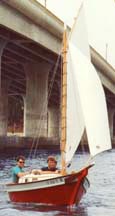 Included with the Video Home-Boatbuilding Course are the complete building
plans with progress drawings and construction photos, materials list, a
Sailing Log for the boat, and access to a Builder-Hotline so if a step still
seems hazy after watching it on the tape, seeing it in the plans, and reading
about it in the complete step-by-step assembly guide, you can get to the
sympathetic ear of an expert WEEKENDER builder to get the help you need.
Included with the Video Home-Boatbuilding Course are the complete building
plans with progress drawings and construction photos, materials list, a
Sailing Log for the boat, and access to a Builder-Hotline so if a step still
seems hazy after watching it on the tape, seeing it in the plans, and reading
about it in the complete step-by-step assembly guide, you can get to the
sympathetic ear of an expert WEEKENDER builder to get the help you need.
L.O.A.: 19'6"
L.O.D.: 16'
BEAM: 6'
DRAFT: 3' (1' w/RUDDER UP)
HULL WEIGHT: 475LBS
SAIL AREA: 120 SQ.FT.
SLEEPS TWO COSY, ONE EASY
CREW; ONE TO FOUR
OPTIONAL POWER TO 5HP, 45 LBS ELECTRIC
COST TO BUILD: FROM UNDER $1500
To order the
10-minute Sailing Video showing the WEEKENDER in action, and being built,
send $15 (refundable with an order for the Video/Plans Package).Click
Here For Ordering Information
To order the 3 hour
WEEKENDER Video/Plans Package, including complete plans, over 3 hours of
video, materials list, folder, Sailing Log, send $69; to order just the
plans , send $32.Click Here
For Ordering Information
International Orders please specify video format (NTSC, PAL, or SECAM).
PAL and SECAM orders add $35 US.

If you're in the mood to watch a project building in action, go
to ProjectCam!
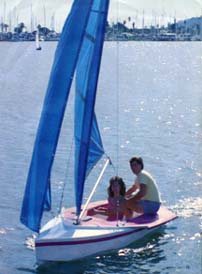
The Wing Dinghy
This lightweight 12-footer is simple to build and all the materials, including
the rig and sail can be found in one trip to a home-center outlet for under
$500. Despite the straightforward building steps, the boat has very quick
performance. With a daggerboard and a full-length keelson to maintain steering
with the daggerboard up, the boat tacks fast yet has great directional stability
at speed. The Wing-Dinghy is really a 12' edition of the very fast "International
14's", with some scaled-down lines of the Lake Garda Racers thrown
in. The boat features a large, fully-battened mainsail, plus jib and kick-up
rudder. The stock hull weighs only 125 lbs, is naturally buoyant, and also
has four flotation compartments with air-out vents. Wing-decks on each side
provide comfortable, controlled seating when hiking out. More advanced builders
might want to use lighter plywood, a carbon-fiber windsurfer mast, and rig
a bowsprit and a third "Jibbaker" sail for extreme speed performance.
Plans are $20 Click
Here For Ordering Information
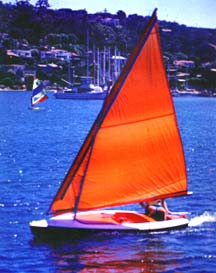
The Ply-Flier
The Ply-Flier is a fast boat. The somewhat narrow hull allows good speed
with the low lateen rig, or when rowing and electro-motoring. The 14' hull
has a built in trolling motor mount (which is entirely sufficient for this
low drag, lightweight boat), outboard oarlocks, and double cockpits for
paddling.
Plans are $18 Click Here
For Ordering Information
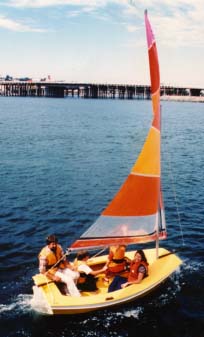
The 3-In-1
When the editors of Family Circle had asked for a triple-purpose boat (sailing
, rowing , and motoring) that was easy for beginners to build, and that
could be carried on top of a car, we got to work. The 3-in-1 soon proved
to be a capable little performer, outreaching our hopes as a multiuse boat.
Only 10' long, the 3-in-1 sails with a surprising amount of spirit in a
breeze, even with a family of four aboard. Sail balance is nice, and tacking
is surefire. The rowing seat doubles as a daggerboard box, and there's a
built in outboard well for small outboards or electrics. Storage fore and
aft provides space for flotation foam or supplies.

The Kayak
The Kayak is experiencing a resurgence in popularity lately, and this doesn't
surprise us a bit. We originally designed the Kayak as a roomy, stable,
and inexpensive boat for calm-water exploring. The Kayak is super-simple
to build and has plenty of room for two adults. It also has a built-in transom
mount for an electric trolling motor that can slip you silently into the
midst of wildlife activity that even paddling might scare off, as well as
being effective as a stealthy fishing platform . This has always been a
fun way to relax, and recent advances in electric motor and gelled battery
technology just make this boat more practical than ever. The 14'4"
hull is a lightweight, 1¦4" plywood box-section, with a keel for
easy paddling.
L.O.A.: 14'4"
BEAM: 34"
WEIGHT: 80LBS
CREW: ONE TO TWO
ELECTRIC AUX. PWR
 Back To The Starting
Page
Back To The Starting
Page
 Send Us E-Mail
Send Us E-Mail